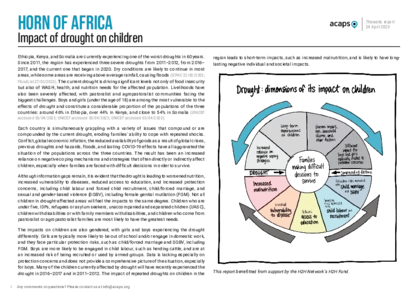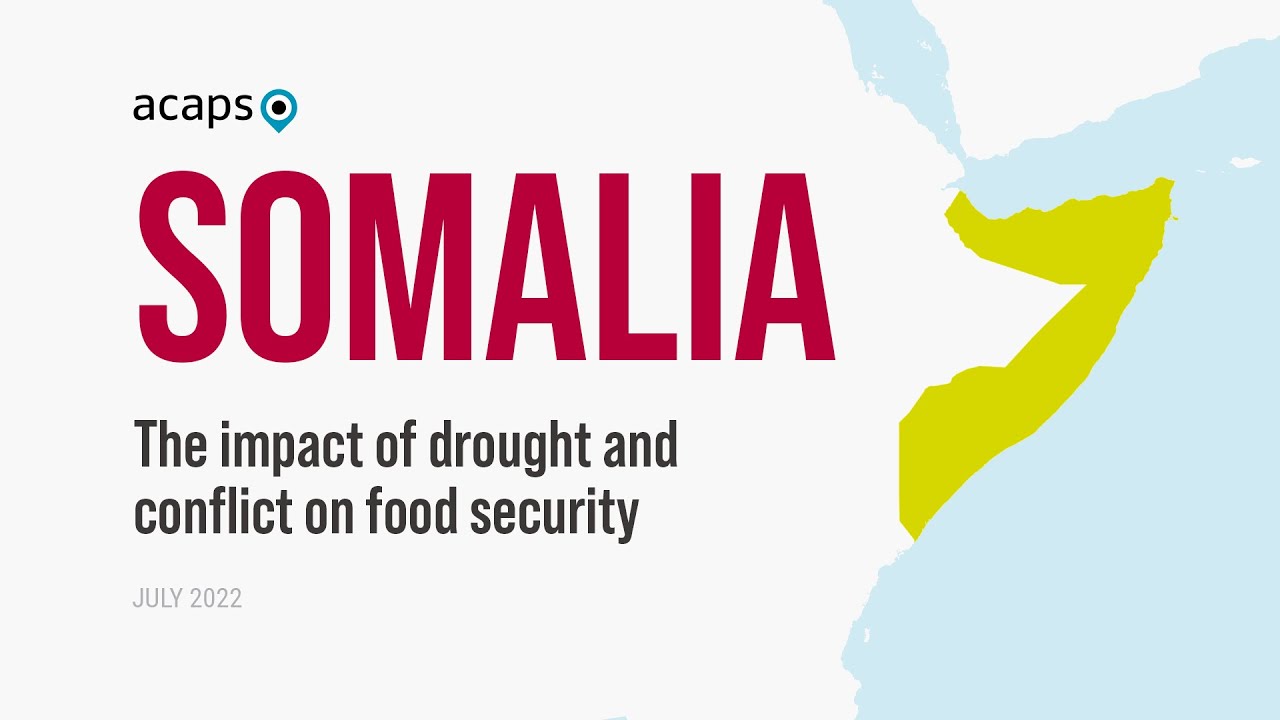Latest updates on country situation
25 February 2025
From April–June 2025, Somalia’s food security and malnutrition crisis is anticipated to worsen significantly, with 4.4 million people projected to experience high acute food insecurity – i.e. Crisis (IPC Phase 3) or worse levels. This marks a 22% increase compared to the same period in 2024. Key drivers include La Niña-induced drought, food prices surpassing the five-year average, limited carryover stocks, high shipping costs, conflict and internal tensions, protests, and insecurity in central, northwestern, and southern regions. During this period, acute malnutrition is expected to escalate, affecting at least 1.7 million children under five (6.25% more than the 1.6 million in the previous period) – further overwhelming an already strained humanitarian response. The US funding suspension, which previously accounted for 67% and 76% of the food security and nutrition response, respectively, has severely disrupted humanitarian operations since January 2025. Humanitarian organisations have not reported securing alternative funding, raising concerns about the capacity to meet escalating needs. (IPC 24/02/2025, ECHO 25/02/2025, AP News 11/02/2025)
10 February 2025
Somalia is facing increasingly dire drought conditions because of prolonged dry spells, intensifying humanitarian needs. The failure of the October–December 2024 Deyr rains has led to severe drought, particularly in southern and central regions. The worst-affected areas include Bakool, Bari, Bay, Galgaduud, Gedo, Hiran, Mudug, Sool, and Togdheer.
The current Jilaal season, marked by extreme heat and aridity, has further depleted water and pasture, deepening livelihood struggles. Forecasts suggest that the 2025 Gu season will bring below-average rainfall, a delayed onset, and rising temperatures, aggravating drought impacts and increasing humanitarian needs. Below-normal rainfall from April–June 2025 is expected to further strain agriculture, while high temperatures intensify water scarcity. From August 2024 to July 2025, around 1.6 million children under five are expected to suffer from acute malnutrition. 4.4 million people were also projected to experience Crisis (IPC Phase 3) or worse food insecurity between October–December 2024. (OCHA 10/02/2025, FAO 29/01/2025, IPC 23/09/2024)
03 December 2024
By 25 November 2024, riverine flooding had affected approximately 40,000 people across 30 villages, with over 13,100 individuals displaced from their homes in Belet Weyne district. The flooding has predominantly affected areas upstream of Belet Weyne town, where around 8,000 hectares of land, including 5,000 hectares of agricultural land, have been submerged. Critical needs include food assistance and livelihood support, healthcare, shelter, NFIs, and WASH interventions. (FAO 11/11/2024, OCHA 03/12/2024, FAO 16/11/2024)
12 November 2024
Between 1–2 November 2024, violent interclan clashes erupted in Buuhoodle district of Togdheer region, northern Somalia. The main driver was political tension between Somaliland and subnational administrations, along with clan disputes. The violence killed approximately 40 people and, by 5 November, had displaced at least 26,000 individuals, primarily pastoralists who had to leave their livestock behind. Residents from Galgal, Qorulugud, and surrounding villages are also fleeing to avoid the escalating risks. Local health centres report that many of the injured and deceased are children, raising concerns about the forced recruitment of minors. (UNHCR 05/11/2024)
29 October 2024
The clan conflict that began in July 2024 in Luuq district, Jubaland state, has escalated. Despite peace efforts, a renewed outbreak of violence on 21 October in Neefsoow and Bishaarow villages has intensified the situation. By 23 October, the insecurity had newly displaced approximately 5,000 individuals, including some who had just recently returned, contributing to a total of nearly 30,000 displaced people. Revenge killings and armed stand-offs between rival clans continue, fuelling fear, psychological trauma, and insecurity, especially among groups such as women, children, older people, and people with disabilities. The volatile security situation, particularly in areas with the presence of non-state armed groups, severely limits humanitarian access and movement. Immediate needs include health and nutrition services, water, sanitation facilities, food assistance, and GBV and child protection services. Many households have sought refuge in remote areas outside Luuq town, complicating relief efforts. (OCHA 23/10/2024, UNHCR 22/10/2024, AllAfrica 21/10/2023)
16 July 2024
On 5 July 2024, interclan conflict erupted in Luuq town, Jubaland state, affecting 100,000 people (including four killed and 42,000 displaced, with 4,000 already previously displaced) by 11 July. The conflict has also significantly disrupted movement, trade, livelihoods, and transport. Some of the displaced have sought refuge in nearby settlements, including Bashiro, Ceel Buur, Dhuyacley, Jaziira, Waajid, and Yurkut. The violence has also burnt down the Naf Iyo Maal IDP site (hosting 735 families) on 6 July, as well as the local market, destroying over 200 businesses. The severe economic impact is likely to threaten livelihoods and increase the food insecurity risk. On 8 July, the Government imposed a temporary dawn-to-dusk curfew, which has since been lifted. Regardless, humanitarian access remains challenging, as a non-state armed group controls all roads to the district. People urgently need assistance, including temporary shelters, health services, clean water, and food. (OCHA 14/07/2024, SomaliSignal 06/07/2024, ECHO 10/07/2024)
26 March 2024
Cholera cases in Somalia are on the rise, mainly affecting Hirshabelle, Puntland, and Southwest states. Since the beginning of 2024, reported cases have tripled compared to the previous three-year average. As at 18 March, there had been over 4,300 cases and 54 deaths reported in 32 districts since 1 January, resulting in a 1.2% case fatality rate, which is above the WHO emergency threshold. The outbreak, worsened by high child malnutrition rates, limited access to clean water, open defecation practices, and poor sanitation, poses a significant threat to communities. Despite efforts to respond to the crisis in affected areas, numerous challenges persist, including a shortage of skilled health workers, significant population movements, insufficient community awareness, inadequate infrastructure at treatment facilities, and a lack of funding. The upcoming Gu rainy season (April–June) may aggravate the situation further. (OCHA 25/03/2024, STC 21/03/2024, The Star 05/03/2024)
current crises
in
Somalia
These crises have been identified through the INFORM Severity Index, a tool for measuring and comparing the severity of humanitarian crises globally.
SOM001 - Complex crisis
Last updated 25/03/2025
Drivers
Conflict
Displacement
Floods
Drought
Crisis level
Country
Severity level
4.4 Very High
Access constraints
5.0
SOM002 - Mixed Migration
Last updated 25/03/2025
Drivers
Displacement
Crisis level
Country
Severity level
2 Low
Access constraints
4.0
Analysis products
on
Somalia
19 March 2025
Somalia: Impact of clan conflicts
DOCUMENT / PDF / 1 MB
This report aims to provide a detailed analysis of the causes, dynamics, and humanitarian impacts of clan-based conflicts in Somalia, with a focus on the recently most affected areas. It explores the historical, sociopolitical, and economic roots of the phenomenon, seeking to inform humanitarian responders, policy makers, and development practitioners.
Attached resources
26 October 2023
Somalia: flooding in Baidoa
DOCUMENT / PDF / 2 MB
Heavy rains that began on 4 October 2023 have resulted in flash floods across Baidoa district, in Bay region, Southwest state, Somalia. The floods had affected more than 122,000 people (20,347 families) as at 23 October. The most affected regions are Baidoa city and the surrounding low-lying areas.
17 August 2023
Somalia: risk of worsening existing humanitarian needs in conflict-affected areas
DOCUMENT / PDF / 518 KB
This report provides a forward-looking analysis of the progressive withdrawal of the African Union Transition Mission, the transition of security operations to the Somali Security Forces (SSF), and how this will worsen existing humanitarian needs in conflictaffected areas.
24 April 2023
Horn of Africa: Impact of drought on children
DOCUMENT / PDF / 5 MB
Ethiopia, Kenya, and Somalia are currently experiencing one of the worst droughts in 60 years. The current drought is driving significant levels not only of food insecurity but also of WASH, health, and nutrition needs for the affected population.
13 April 2023
Somalia: Key crises to watch in 2023
DOCUMENT / PDF / 1 MB
This report provides an overview of four key humanitarian crises across Somalia that are expected to deteriorate or see a significant humanitarian impact during 2023. It aims at informing humanitarian decision-making and programming by anticipating humanitarian needs in different regions of the country.







